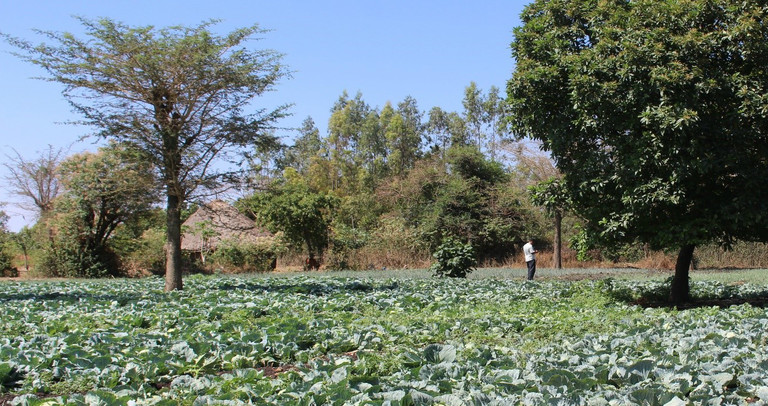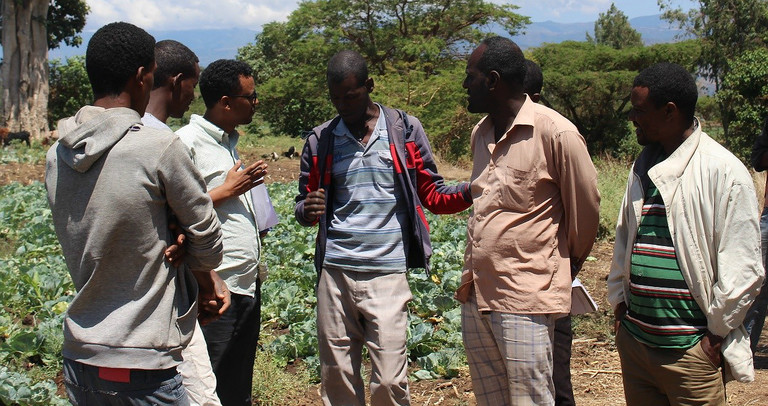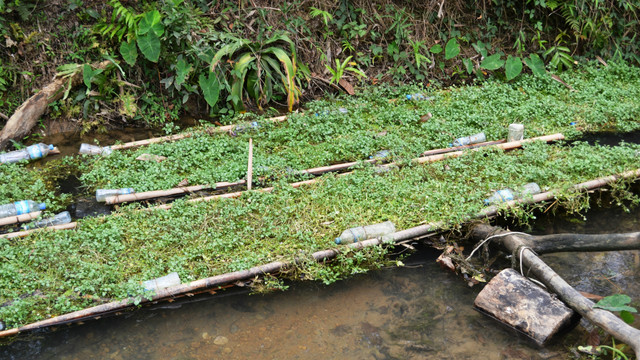Bright spots of success: local adaptation brings answers to the global climate crisis
From a smallholder farming community in south-central Ethiopia come inspiring stories of adaptation and resilience in the face of climate change.


Agroforestry: coffee and pepper grow beneath papaya trees and banana palm (Photo: Teresa Corcoran/IIED)
At the UN Secretary-General’s climate summit in September, a day before the annual General Assembly kicks off, nations will showcase their plans to cut emissions to tackle the escalating climate crisis. Countries will also demonstrate how they are accelerating action to adapt to climate change. The summit is a chance for a breakthrough; an opportunity for global leaders to shift gear on the way adaptation is done.
Global to local
National adaptation plans and strategies must be anchored in real-world action; international responses for adapting to climate change can only work if they draw on knowledge and success from the ground.
The community-based adaptation (CBA) community of practice convened by IIED and partners gathers regularly to share what’s bringing tangible results in its communities and to brainstorm fresh ideas.
Following the four-day gathering of the CBA champions in Addis Ababa in April I visited the district of Meskan in south-central Ethiopia. There I met a community alive to the adaptation challenge.
Meskan lies on western margin of Ethiopia’s Rift Valley, 140km south of the capital Addis Ababa. In these already arid lands, temperatures are rising. Droughts are becoming more frequent and prolonged. If the rains do come, they are often excessive and in short bursts – degrading the land and wiping out crops.
Small-scale farming dominates this area. Most smallholder farmers rely on rain-fed crops for survival, leaving them highly vulnerable to the changes in seasonal rainfall. Even with dramatic cuts in emissions, future climate changes are expected to cause erratic crop failures.
The shocks are set to continue and for the people of Meskan, climate problems are deepening. Nonetheless, inspiring stories of innovation and resilience dot the landscape.
Bumping up production
Over a 12-year period, and as rainfall has become increasingly erratic, farmer Shemsu Hussein has moved from rain-fed agriculture to intensive small-scale irrigation – with dramatic results to his farm’s productivity.

Shemsu explained that SOS Sahel Ethiopia – an NGO working with smallholder farmers and marginalised pastoralists – approached him in 2006, and gave him training on irrigation, advice on what vegetables to grow as well as a subsidy to buy an irrigation pump for a group of five farmers. The group has been using the water pump on a rotation basis. After just one cycle of vegetable production he was able to produce and sell vegetables by himself.
“With more reliable water sources I’ve been able to move from growing purely maize, to onion, tomato and cabbage. And instead of producing in only one season, I now produce two to three times a year. My overall harvest is up to six times greater.”
Shemsu says he was amazed when he started this new way of farming, especially by the income from growing tomatoes.
“I was staggered by how much more money I could make. It was almost frightening! Now I have enough money to send my children to school. And before we ate mainly cereals. Now we’re growing a wider variety of vegetables, so my family are eating better.

More production on the farm means Shemsu has built his resilience of the longer term.
“I’ve even made enough money to build a house in the town. With another property and money in the bank, our lives are stable in a way they weren’t 10 years ago.”
Work grows for a local cooperative
A short drive away, the Bekelcha farming cooperative is at work. The cooperative has over 100 members, including farmers Bobas Elku and Teshale Gala. They explained they began using irrigation systems in 2015 and now each farmer in the cooperative irrigates more than 0.5 hectares.
“Before irrigation we were idle for months. The rains would come, but quickly dry up. Since our cooperative has started using irrigation methods, things have changed. We’re producing tomatoes, onions, green peppers, cabbages… we’re busy!”

Challenges
Irrigation is not without its difficulties; the method draws heavily from water from the ground. So while Shemsu’s family and the farming cooperative are benefiting from better water access now, the strain on groundwater levels may spell problems for future generations if groundwater recharge does not match increased use for irrigation.

But there are options. Ato Getachew Eshete is a program manager at SOS Sahel Ethiopia, an NGO working with smallholder farmers and marginalised pastoralists. The programme is based on climate-resilient agriculture, supported by Irish Aid, and helps smallholder farmers improve their lives through better management of their environment.
He explained the possible avenues for restoring the water: “We need to work out alternatives and there are routes we could try. It’s all about recharging the ground and river water and improving the efficiency of irrigation water use. To do this, the project plans to undertake hydrological study in the area, rehabilitate and restore the critical watersheds and introduce drip irrigation.”
Building resilience
Jemale Husaine and his wife Rauda changed their fortunes following training from SOS Sahel Ethiopia in agroforestry. Under this method, trees are grown in and around crops – mimicking the different ‘layers’ of a forest.
Agroforestry leads to healthier soils and higher yields. On the upper levels of Jemale’s farm are avocado, papaya and banana trees. Below, in the shade of the trees, coffee grows. Timber from the trees can be used for household firewood or sold as timber.

Not only has production increased dramatically, the family is more resilient to climate change. In the erratic weather, depending on a single crop is risky but with agroforestry, if one crop fails, farmers can harvest another.
Part of their training included learning how to graft seeds – avocado in particular. Crops grown from grafting are more productive and resistant to disease and drought. Avocado can be sold at a premium price and presents solid opportunities for income generation.
“Our lives have changed. We generated enough income to build a new house and can now send our children to school. We’ve also bought two oxen to support our farming. Looking to the future, we’d like to expand, to grow even more crops.”

As well as income benefits, agroforestry brings social advantages, particularly for women. Jemale’s wife explained that having a reliable harvest and supply of wood takes some of the strain from her responsibilities. Spending less time going to market for food and fuel frees up to time to spend with her five children and to concentrate on running the household.
Answers
These stories of success from Meskan are just drops from a rich pool. Across the world, communities are adapting to the changing climate and providing concrete evidence of what’s working.
With louder voice and growing energy, communities are demanding that adaptation solutions respond to their real needs and address the drivers of vulnerability. At the September summit, IIED and CBA partners will urge decision makers at the highest level to actively prioritise locally-driven adaptation in the fight against climate change, and the urgent need for mechanisms that direct finance to the local level so that it can be rolled out at scale.
Communities are showing they have answers; policymakers must arrive in September with open ears.
- The 14th international conference on CBA (CBA14) will take place in September 2020. Sign up to receive further updates on CBA.



